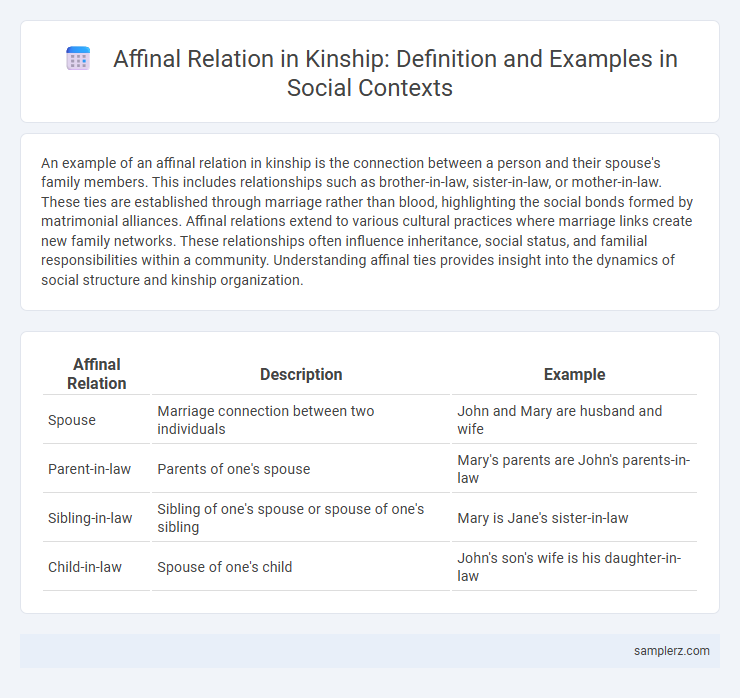An example of an affinal relation in kinship is the connection between a person and their spouse's family members. This includes relationships such as brother-in-law, sister-in-law, or mother-in-law. These ties are established through marriage rather than blood, highlighting the social bonds formed by matrimonial alliances. Affinal relations extend to various cultural practices where marriage links create new family networks. These relationships often influence inheritance, social status, and familial responsibilities within a community. Understanding affinal ties provides insight into the dynamics of social structure and kinship organization.
Table of Comparison
| Affinal Relation | Description | Example |
|---|---|---|
| Spouse | Marriage connection between two individuals | John and Mary are husband and wife |
| Parent-in-law | Parents of one's spouse | Mary's parents are John's parents-in-law |
| Sibling-in-law | Sibling of one's spouse or spouse of one's sibling | Mary is Jane's sister-in-law |
| Child-in-law | Spouse of one's child | John's son's wife is his daughter-in-law |
Understanding Affinal Relations in Social Kinship
Affinal relations in social kinship refer to connections established through marriage, such as the bond between a husband and his wife's parents or siblings. These relationships play a crucial role in defining social obligations, inheritance rights, and family alliances within kinship networks. Understanding affinal ties enhances insights into social structure, marital alliances, and the distribution of social roles across extended families.
Defining Affinal Kin: An Overview
Affinal kin refers to relatives connected through marriage rather than blood, including in-laws such as a spouse's parents, siblings, and extended family members like brothers-in-law and sisters-in-law. This relationship differs from consanguineal kinship, which is based on direct biological descent. Understanding affinal kin is crucial in social anthropology and family studies, as these ties influence social obligations, inheritance patterns, and cultural practices within kinship networks.
Marriage as the Key Affinal Bond
Marriage serves as the primary affinal relation in kinship systems, connecting individuals through legally and socially recognized unions. This bond creates ties between spouses and extends to in-laws, forming networks that influence inheritance, residence, and social obligations. Affinal relationships established by marriage are critical in shaping family structure, alliance formation, and community cohesion.
In-Laws: Classic Examples of Affinal Relationships
Affinal relationships are kinship ties established through marriage, with in-laws serving as classic examples, including mother-in-law, father-in-law, sister-in-law, and brother-in-law. These connections extend family networks beyond biological ties, influencing social support systems and familial responsibilities. In anthropological studies, affinal bonds often shape inheritance patterns, residence rules, and alliance formations within communities.
The Role of Step-relations in Affinal Kin
Step-relations in affinal kin play a crucial role in shaping family dynamics and social support networks, often bridging biological and social bonds within households. These relationships, such as step-parents and step-siblings, contribute to caregiving responsibilities and inheritance patterns, reflecting complex kinship systems beyond blood ties. Research highlights that step-relations can influence identity formation and emotional attachments, emphasizing their importance in contemporary family structures.
Cultural Variations in Affinal Connections
Affinal relations, such as those formed through marriage, vary significantly across cultures, reflecting diverse social norms and kinship structures. In many Indigenous Australian communities, affinal ties extend beyond the nuclear family to include extensive ritual obligations and reciprocal relationships with the spouse's clan. Among the Nuer of Sudan, affinal connections influence political alliances and resource sharing, illustrating the deep cultural integration of marriage into social and economic networks.
Social Functions of Affinal Kinship
Affinal relations in kinship, such as marriage ties between spouses, create social bonds that extend kin networks and foster alliance formation between families. These ties often regulate social obligations, including mutual support, resource sharing, and the negotiation of rights and responsibilities within the community. Affinal kinship enhances social cohesion by facilitating cooperation and conflict resolution across different family units.
Affinal Networks and Social Support
Affinal relations, such as those between in-laws, form crucial affinal networks that expand social support systems beyond blood ties. For example, the relationship between a spouse and their partner's relatives often facilitates resource sharing, emotional assistance, and conflict mediation within extended families. These affinal connections enhance social cohesion by integrating diverse kin groups into supportive community structures.
Affinal Relations Versus Consanguineal Ties
Affinal relations refer to connections established through marriage, such as the bond between a person and their spouse's family, contrasting with consanguineal ties, which are blood relationships like those between parents and children or siblings. For instance, a son-in-law has an affinal relationship with his spouse's parents, whereas his relationship with his own parents remains consanguineal. Understanding the distinction between affinal and consanguineal relations is essential for analyzing kinship structures and social obligations in various cultures.
Challenges and Benefits of Affinal Relationships
Affinal relationships, formed through marriage such as between in-laws, often present challenges including navigating differing family traditions and managing boundaries, which can lead to conflict or misunderstandings. The benefits of these connections include expanded social networks, emotional support, and strengthened family cohesion by fostering mutual respect and cooperation. Understanding cultural nuances and practicing open communication are essential to transforming potential challenges into opportunities for growth and unity within affinal ties.

example of affinal relation in kin Infographic
 samplerz.com
samplerz.com